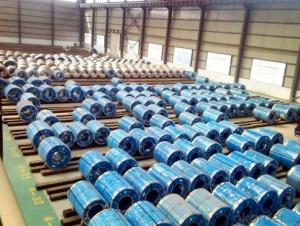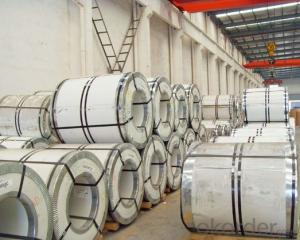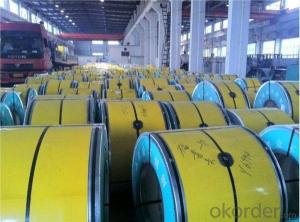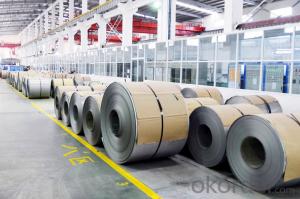Stainless Steel Coil 304/316 Hot / Cold Rolled Grade NO.1
- Loading Port:
- Tianjin
- Payment Terms:
- TT OR LC
- Min Order Qty:
- 20 m.t.
- Supply Capability:
- 4000 m.t./month
OKorder Service Pledge
OKorder Financial Service
You Might Also Like
Stainless Steel Sheet/ Coil 304/ 316/ 304L/ 316L Hot rolled & Cold rolled
Product details:
Item | 304/ 316 stainless steel coil manufacturer |
Technical | Hot rolled and cold rolled |
Standard | ASTM A240,GB/T3280-2007,JIS4304-2005,ASTM A167,EN10088-2-2005,etc |
Surface | 2B,2D,BA,NO.1,NO.4,NO.8, 8K, mirror ,checkered ,embossed ,hair line, sand blast, etching, etc |
Thickness | 0.01~30mm |
Width | 1000mm,1219mm,1500mm,1800mm,2000mm,2500mm,etc |
Package | Standard export package, suit for all kinds of transport, or as required |
Export to | Ireland,Singapore,Indonesia,Ukraine,Saudi Arabia,Spain,Canada,USA, Brazil,Thailand,Korea,Iran,India,Egypt,Malaysia,Dubai,Viet Nam,Peru,Mexico,South Africa,Kuwait,Oman,Russia,etc |
Container Size | 20ft GP:5898mm(Length)x2352mm(Width)x2393mm(High) 40ft GP:12032mm(Length)x2352mm(Width)x2393mm(High) 40ft HC:12032mm(Length)x2352mm(Width)x2698mm(High) |
Application | Stainless steel coil applies to construction field, ships building industry, petroleum, chemical industries, war and electricity industries, food processing and medical industry, boiler heat exchanger, machinery and hardware fields. Stainless steel coil can be made according to the customers requirements. |
Contact | If you have any question,please feel free to contact me . We are sure your inquiry or requirements will get prompt attention. |
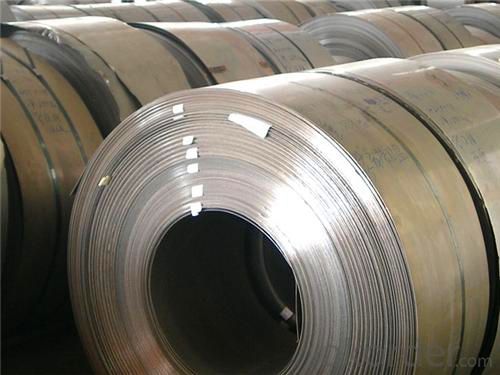
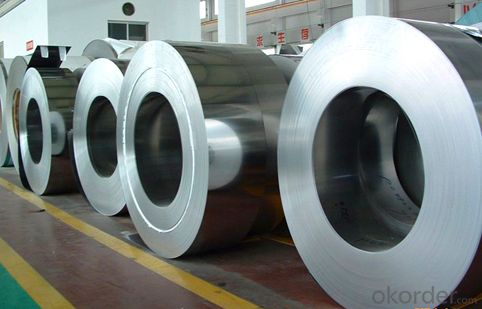
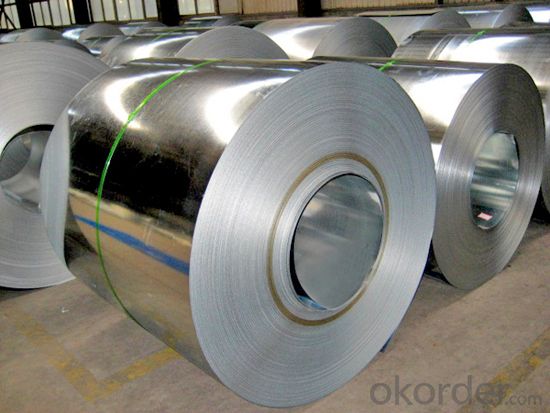
- Q:What are the different surface treatments for stainless steel strips?
- There are several different surface treatments available for stainless steel strips, each serving a specific purpose and providing unique benefits. Some of the most common surface treatments include: 1. Mill Finish: This is the untreated surface of stainless steel, typically characterized by a smooth, slightly reflective finish. It is the standard finish directly from the mill and is suitable for many applications where aesthetics are not a primary concern. 2. Polished Finish: This treatment involves polishing the stainless steel surface to a high gloss or mirror-like finish. It enhances the appearance of the material and is often used in decorative applications, such as architectural elements or interior design. 3. Brushed Finish: Also known as satin finish, this treatment involves brushing the stainless steel surface with fine abrasive materials in a unidirectional pattern. It creates a textured, matte appearance that is resistant to fingerprints and scratches. Brushed finish is commonly used in appliances, kitchen equipment, and automotive trims. 4. Bead Blasted Finish: In this treatment, small glass beads are blasted at high pressure onto the stainless steel surface, creating a uniform, non-reflective finish. It provides a unique, textured appearance and is often used in industrial or architectural applications where a matte, low-glare surface is desired. 5. PVD Coating: Physical Vapor Deposition (PVD) is a process where a thin layer of coating is applied to the stainless steel surface using vacuum deposition techniques. This coating can provide various colors, such as gold, black, or bronze, as well as enhanced durability and corrosion resistance. 6. Electropolishing: This treatment involves immersing the stainless steel strip in an electrolyte solution and applying an electrical current to remove a thin layer of material from the surface. It results in a smooth, shiny finish with improved resistance to corrosion and bacterial growth. Electropolishing is commonly used in medical, pharmaceutical, and food processing equipment. It is important to consider the specific requirements of your application and consult with a stainless steel supplier or surface treatment specialist to determine the most suitable surface treatment for your stainless steel strips.
- Q:Are stainless steel strips suitable for gas turbines?
- Yes, stainless steel strips are suitable for gas turbines. Stainless steel is known for its excellent corrosion resistance, high temperature strength, and durability, making it a suitable material for the harsh working environment of gas turbines. It can withstand the high temperatures and pressures involved in the operation of gas turbines, making it a reliable choice for various components and applications.
- Q:How do stainless steel strips resist crevice corrosion in seawater?
- The unique chemical composition and passive protective layer of stainless steel strips make them resistant to crevice corrosion in seawater. Stainless steel primarily consists of iron, chromium, and other alloying elements like nickel and molybdenum. The presence of high chromium content, typically above 10.5%, is crucial in preventing crevice corrosion. When stainless steel strips come into contact with seawater, the chromium in the alloy reacts with oxygen to create a thin, transparent oxide layer on the surface, known as the passive layer. This passive layer is highly resistant to corrosion, including crevice corrosion. It acts as a protective barrier between the metal and the corrosive environment, preventing the initiation and spread of corrosion in crevices or tight spaces. The passive layer has the ability to self-heal. If it is damaged or removed, it can quickly reform in the presence of oxygen. This characteristic ensures long-term protection against crevice corrosion in seawater, even in challenging marine environments where the metal is constantly exposed to chloride ions and other aggressive elements. Moreover, the addition of alloying elements such as nickel and molybdenum further enhances the corrosion resistance of stainless steel strips. Nickel improves the stability and durability of the passive layer, while molybdenum enhances the alloy's ability to resist pitting and crevice corrosion in chloride-rich environments like seawater. In conclusion, the resistance of stainless steel strips to crevice corrosion in seawater is due to the formation of a protective passive layer on their surface. The high chromium content, along with other alloying elements, enhances the corrosion resistance and durability of the material, making it an excellent choice for various marine applications.
- Q:Can stainless steel strips be used in nuclear power plants?
- Yes, stainless steel strips can be used in nuclear power plants. Stainless steel is a commonly used material in the construction of nuclear power plants due to its excellent corrosion resistance, high strength, and heat resistance properties. It is used in various applications, including the fabrication of reactor vessels, steam generators, piping systems, and other components. Stainless steel is preferred in these environments as it can withstand the harsh conditions and high temperatures associated with nuclear power generation. Additionally, stainless steel is highly resistant to radiation damage, making it suitable for use in nuclear power plants.
- Q:How do stainless steel strips perform in cryogenic environments?
- Stainless steel strips perform well in cryogenic environments as they exhibit excellent resistance to low temperatures, maintaining their strength, toughness, and corrosion resistance.
- Q:Can stainless steel strips be used in water treatment plants?
- Yes, stainless steel strips can be used in water treatment plants. Stainless steel is known for its corrosion resistance, making it suitable for applications in water treatment plants where it will be exposed to water and various chemicals. It provides durability and long-lasting performance, making it an ideal material for components and structures used in water treatment processes.
- Q:Can stainless steel strips be used in the production of medical instruments?
- Yes, stainless steel strips can be used in the production of medical instruments. Stainless steel is a popular choice for medical instruments due to its excellent corrosion resistance, high strength, and durability. It is also easy to clean and sterilize, making it suitable for use in sterile environments. Stainless steel strips can be used to manufacture various medical instruments such as surgical scissors, forceps, scalpels, and orthopedic implants. The material's properties ensure that the instruments remain reliable, safe, and long-lasting, making it a preferred choice in the medical industry.
- Q:What are the different types of edges for stainless steel strips?
- The different types of edges for stainless steel strips include mill edge, slit edge, deburred edge, and rounded edge.
- Q:Are stainless steel strips suitable for decorative trim?
- Yes, stainless steel strips are suitable for decorative trim. Stainless steel is a versatile material that offers a sleek and modern aesthetic, making it a popular choice for decorative applications. It has a polished and reflective surface, which adds a touch of sophistication and elegance to any space. Stainless steel strips are durable, corrosion-resistant, and easy to clean, making them ideal for areas that require low maintenance. They can be used in various settings such as kitchens, bathrooms, and commercial spaces to create a contemporary and stylish look. Additionally, stainless steel strips can be easily customized and fabricated into different shapes and sizes, allowing for endless design possibilities. Overall, stainless steel strips are a great choice for adding a decorative touch to any interior or exterior space.
- Q:How do you prevent corrosion fatigue of stainless steel strips?
- Corrosion fatigue of stainless steel strips can be prevented by implementing various measures such as proper surface preparation, avoiding exposure to corrosive environments, using corrosion inhibitors, applying protective coatings, and maintaining appropriate stress levels within the material. Regular inspections and maintenance can also help identify and address any potential issues before they escalate.
1. Manufacturer Overview |
|
|---|---|
| Location | |
| Year Established | |
| Annual Output Value | |
| Main Markets | |
| Company Certifications | |
2. Manufacturer Certificates |
|
|---|---|
| a) Certification Name | |
| Range | |
| Reference | |
| Validity Period | |
3. Manufacturer Capability |
|
|---|---|
| a)Trade Capacity | |
| Nearest Port | |
| Export Percentage | |
| No.of Employees in Trade Department | |
| Language Spoken: | |
| b)Factory Information | |
| Factory Size: | |
| No. of Production Lines | |
| Contract Manufacturing | |
| Product Price Range | |
Send your message to us
Stainless Steel Coil 304/316 Hot / Cold Rolled Grade NO.1
- Loading Port:
- Tianjin
- Payment Terms:
- TT OR LC
- Min Order Qty:
- 20 m.t.
- Supply Capability:
- 4000 m.t./month
OKorder Service Pledge
OKorder Financial Service
Similar products
New products
Hot products
Related keywords


